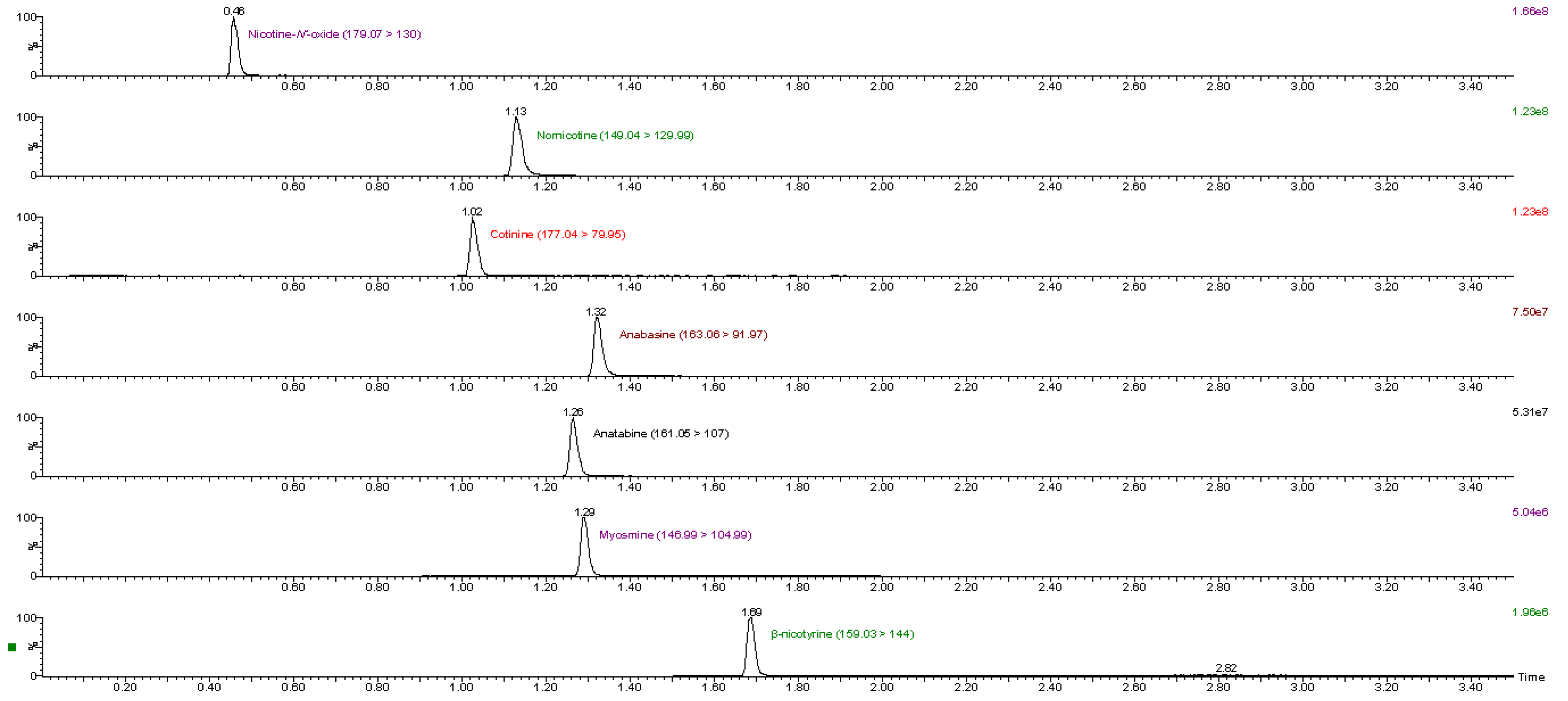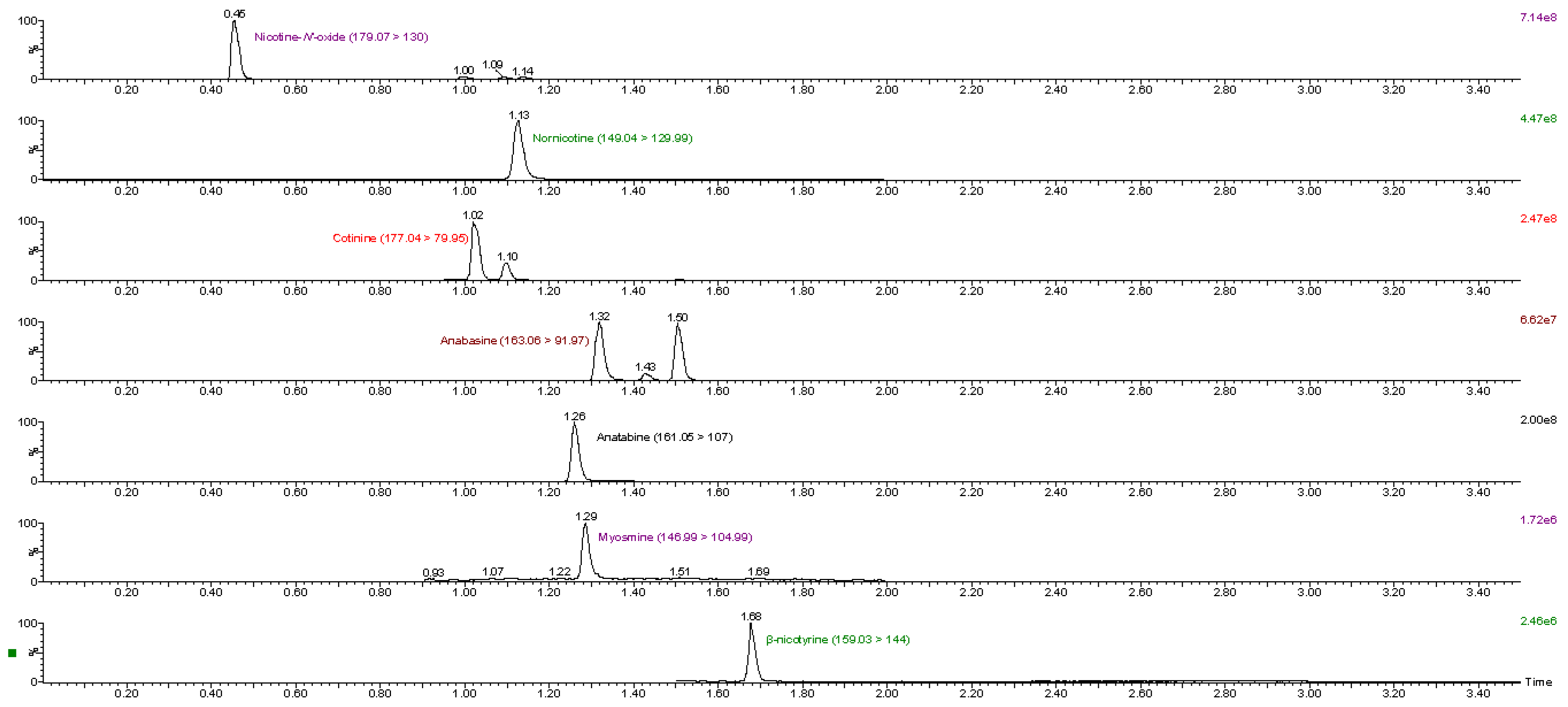1. Introduction
Nicotine-containing tobacco-free oral pouches belong to a new product category that has gained market shares in recent years [
1]. The nicotine pouches are similar to snus, but they contain different non-tobacco fillers and nicotine instead of tobacco leaves. Additionally, the nicotine pouches usually contain pH adjusters, processing aids, artificial sweeteners, flavors, fibers (pouch material) and stabilizers. These products come in a variety of flavors and nicotine content, as well as brand names such as ZYN
®, Velo and on!
®, manufactured by different manufacturers. Although the long-term health effects of nicotine pouches have not been established yet, it is suggested that they are less harmful than cigarettes [
2].
The nicotine used in the manufacturing of nicotine pouches is usually extracted from the tobacco plant; thus, related alkaloids (e.g., nornicotine, anatabine and anabasine) may be found as impurities in small quantities [
3]. Moreover, due to environmental factors such as temperature, humidity, light and storage containers, the degradation of nicotine may occur, giving rise to the formation of nicotine degradation products (e.g., cotinine, nicotine-
N’-oxide, myosmine and β-nicotyrine) [
4]. In the US and European pharmacopoeias, there are recommendations for the purity of nicotine used in pharmaceutical products [
5,
6] but not in other nicotine-containing products. The nicotine impurities are specified in the European Pharmacopoeia monograph 1452 as nicotine-N’-oxide, cotinine, nornicotine, anatabine, myosmine, anabasine and β-nicotyrine, while the US Pharmacopeia (USP)-grade nicotine requires single impurities to be less than 0.5% (5 mg/g) and total impurities to be less than 1% (10 mg/g) [
5,
6].
There are several methods to determine the levels of nicotine and its metabolites (e.g., cotinine, nicotine-
N’-oxide, nornicotine) using liquid chromatography coupled to tandem mass spectrometry (LC–MS/MS) in human urine [
7,
8,
9] as well as plasma, semen and sperm by using LC–Orbitrap–MS [
10]. Nicotine and related alkaloids (anabasine, anatabine) have also been determined using gas chromatography coupled to flame ionization detection (FID), nitrogen–phosphorus detection (NPD) and MS in tobacco-containing products and tobacco smoke [
11,
12,
13,
14]. Several methods are also available for the analysis of nicotine-related alkaloids and impurities in electronic cigarette liquids, cartridges and aerosols [
4,
15,
16,
17].
However, there are currently no published or recommended methods available for the analysis of nicotine impurities in nicotine pouches. The above-mentioned methods have not been investigated, and may not be entirely suitable for the analysis of nicotine pouches due to differences in their matrix composition. In this paper, we describe a sensitive and selective method using LC–MS/MS for the simultaneous determination of seven nicotine impurities in four nicotine pouch products, as well as five tobacco products (namely, CORESTA Smokeless Tobacco Reference Products CRP 1.1, CRP 2.1, CRP 3.1, CRP 4.1 and a cigar). Although there are no regulatory requirements or recommendations for these impurities in nicotine products, the method can be used for quality control purposes (e.g., to check the purity of nicotine, as well as for stability studies of nicotine pouches by monitoring the degradation of nicotine).
2. Materials and Methods
2.1. Standards and Reagents
Standards of nicotine-N’-oxide, nornicotine, anabasine, anatabine, cotinine, myosmine, β-nicotyrine, nicotine-N’-oxide-d3, nornicotine-d4, anabasine-d4, anatabine-d4, cotinine-d3, myosmine-d4 and β-nicotyrine-d3 (purity >95% for all standards) were purchased from Toronto Research Chemicals (Toronto, ON, Canada). Acetonitrile (ACN) (HPLC grade), isopropanol (HPLC grade), formic acid (98–100%, p.a. grade), ammonium formate (LC–MS grade), ammonium hydroxide (25%, LC–MS grade) and acetic acid (LC–MS grade) were obtained from VWR, Radnor, PA, USA. Methanol (MeOH) (HPLC grade) was purchased from Fisher Scientific, Waltham, MA, USA. Water was purified using a Milli-Q® Integral 3 (Millipore SAS, Molsheim, France) water purification system equipped with a Millipak® Express 40 0.22 µm membrane filter (Millipore Corp., Burlington, MA, USA).
Stock solutions with concentrations of approximately 1 mg/mL in methanol were prepared for all the standards and the internal standards, respectively. Intermediate standard solutions were prepared from the stock solutions at three concentration levels, 1, 20 and 200 µg/mL. An intermediate standard solution was prepared for the internal standards as well, containing 18.75 μg/mL of β-nicotyrine-d3 and myosmine-d4 and 6.25 μg/mL of residual internal standards. Six (seven for nicotine-N’-oxide) calibration standards dissolved in 0.2% ammonium hydroxide were also prepared. Stock solutions and intermediate standard solutions were stored in a freezer (−18 °C). Calibration standard solutions were stored in a refrigerator (4–6 °C).
2.2. Sample Handling and Preparation
The CRP samples were stored at approximately −20 °C until analyses were performed, as recommended by CORESTA [
18]. Prior to analysis, the CRPs were placed in a refrigerator for 24 h and then equilibrated to ambient conditions before opening. After opening, the samples were placed in a sealed container for short-term storage in the refrigerator. The nicotine pouches and cigar were handled in the same way as the CRPs. It was also noticed that the storage of nicotine pouches prior to re-analysis played a significant role in obtaining accurate results. After opening, it is not recommended to store these samples in the freezer.
An amount of 1.0 ± 0.2 g sample was weighed out in a 100 mL Erlenmeyer flask. The nicotine and CRP 1.1 pouches were cut in two lengthwise. CRP 2.1, CRP 3.1 and CRP 4.1 were weighted out as is, without grinding, while the cigar was ground to obtain a homogeneous sample. A total of 100 μL of internal standard solution and 50 mL of extraction solution (100 mM ammonium formate buffer (pH 3)) were added to the sample. The sample was then shaken on an orbital shaker for 40 min at 130 rpm and then allowed to settle for about 5 min to facilitate filtering. A total of 100 μL of sample solution was transferred to a filter vial (0.2 μm Whatman Mini-UniPrep, Fisher Scientific, USA), while 400 μL 0.3 M ammonium hydroxide was added with Multipette.
2.3. Chromatographic and Mass Spectrometric Conditions
The analyses were performed on a UPLC system from Waters Corp., Milford, CT, USA, consisting of an Acquity I-Class UPLC with binary pumps, fitted with an Acquity Sample manager with a cooling system, an auto-injector with a flow-through needle injection and a column switch with a column oven. The chromatographic separation was performed on a Waters Acquity UPLC BEH C18 column, 2.1 mm × 100 mm, 1.7 µm particle size (Part # 186002352) connected to a Waters pre-filter (Assay, Frit, 0.2 µm, 2.1 mm, part. No. 289002078). Mobile phase A was 0.1% ammonium hydroxide, 10 mM ammonium acetate buffer in MQ water; mobile phase B was 0.1% ammonium hydroxide, 10 mM ammonium acetate buffer in ACN. The injection volume was 1 μL, and the mobile phase flow rate was set to 600 μL/min. The gradient condition used was as follows: initial 7% B, 0.2 min 7% B, 1.25 min 45% B, 1.80 min 45% B, 2.20 min 98% B, 2.50 min 98% B and 2.51 min 7% B. The system was equilibrated for 1 min with 7% B before each run.
The MS system was a Waters Xevo TQ-XS, and the MS parameters were set as follows: capillary voltage 0.50 kV, cone voltage 30 V, desolvation 1000 L/h, cone 150 L/h, nebulizer 7 bar, collision gas flow 0.15 mL/min, desolvation temperature 600 °C and source temperature 150 °C. The dwell time for each transition was 0.150 s, except for the transitions of β-nicotyrine and β-nicotyrine-d3 that had dwell times of 0.041 s. Quantitative analyses were performed in MS/MS mode. The analyte-specific parameters are shown in
Table 1. Data were acquired and processed with Waters MassLynx (Ver. 4.2.; Waters Corp., Milford, CT, USA).







